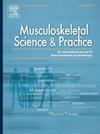Prognostic factors for upper limb and shoulder-specific disability and quality of life in participants suffering from frozen shoulder. A multicentric prospective single-cohort study
IF 2.2
3区 医学
Q1 REHABILITATION
引用次数: 0
Abstract
Background
Identifying prognostic factors for patient outcomes is crucial in research and clinical practice, as these variables significantly impact healthcare journeys.
Aim
To investigate prognostic factors for upper limb and shoulder-specific disability and quality of life in patients with frozen shoulder (FS).
Method
This multicentric prospective single-cohort study included 120 FS participants (72 females). Demographic and patient-related data were collected. Baseline upper limb and shoulder-specific disability (through DASH and SPADI scores) and quality of life (via EUROQoL 5D-5L) were dependent variables. Putative prognostic factors included daily pain, symptoms’ duration, affected arm, kinesiophobia, symptom duration, comorbidities, and corticosteroid injections. Participants underwent 12 weeks of multimodal treatment. Multivariate linear regression, adjusted for age and gender, assessed variable associations.
Results
Baseline DASH scores significantly predicted post-treatment upper limb disability (β = 0.317, 95 %CI 0.145 to 0.489). For SPADI, only baseline Tampa Scale was significant (β = 0.630, 95 %CI 0.146 to 1.113). Comorbidities were the sole significant predictor for EUROQoL 5D-5L (β = −0.739, 95 %CI -1.300 to −0.177).
Conclusion
Baseline DASH scores predict future upper limb disability, while baseline kinesiophobia predicts shoulder-specific disability. Comorbidities are a significant prognostic factor for quality of life. These findings enhance our understanding of FS prognosis under conservative treatment, facilitating a more precise medical approach.
冻肩患者上肢和肩部特异性残疾的预后因素及生活质量。一项多中心前瞻性单队列研究
背景:在研究和临床实践中,确定患者预后因素至关重要,因为这些变量会显著影响医疗保健过程。目的探讨冻疮(FS)患者上肢和肩部特异性残疾的预后因素及生活质量。方法本研究为多中心前瞻性单队列研究,纳入120例FS患者(女性72例)。收集了人口统计和患者相关数据。基线上肢和肩部特异性残疾(通过DASH和SPADI评分)和生活质量(通过EUROQoL 5D-5L)是因变量。推测的预后因素包括每日疼痛、症状持续时间、受影响的手臂、运动恐惧症、症状持续时间、合并症和皮质类固醇注射。参与者接受了12周的多模式治疗。多变量线性回归,调整年龄和性别,评估变量关联。结果基线DASH评分可显著预测治疗后上肢功能障碍(β = 0.317, 95% CI 0.145 ~ 0.489)。对于SPADI,只有基线坦帕量表具有显著性(β = 0.630, 95% CI 0.146至1.113)。合并症是EUROQoL 5D-5L的唯一显著预测因子(β = - 0.739, 95% CI -1.300至- 0.177)。结论基线DASH评分可预测未来上肢残疾,而基线运动恐惧症可预测肩部特异性残疾。合并症是影响生活质量的重要预后因素。这些发现增强了我们对FS保守治疗预后的认识,促进了更精确的医疗方法。
本文章由计算机程序翻译,如有差异,请以英文原文为准。
求助全文
约1分钟内获得全文
求助全文
来源期刊

Musculoskeletal Science and Practice
Health Professions-Physical Therapy, Sports Therapy and Rehabilitation
CiteScore
4.10
自引率
8.70%
发文量
152
审稿时长
48 days
期刊介绍:
Musculoskeletal Science & Practice, international journal of musculoskeletal physiotherapy, is a peer-reviewed international journal (previously Manual Therapy), publishing high quality original research, review and Masterclass articles that contribute to improving the clinical understanding of appropriate care processes for musculoskeletal disorders. The journal publishes articles that influence or add to the body of evidence on diagnostic and therapeutic processes, patient centered care, guidelines for musculoskeletal therapeutics and theoretical models that support developments in assessment, diagnosis, clinical reasoning and interventions.
 求助内容:
求助内容: 应助结果提醒方式:
应助结果提醒方式:


